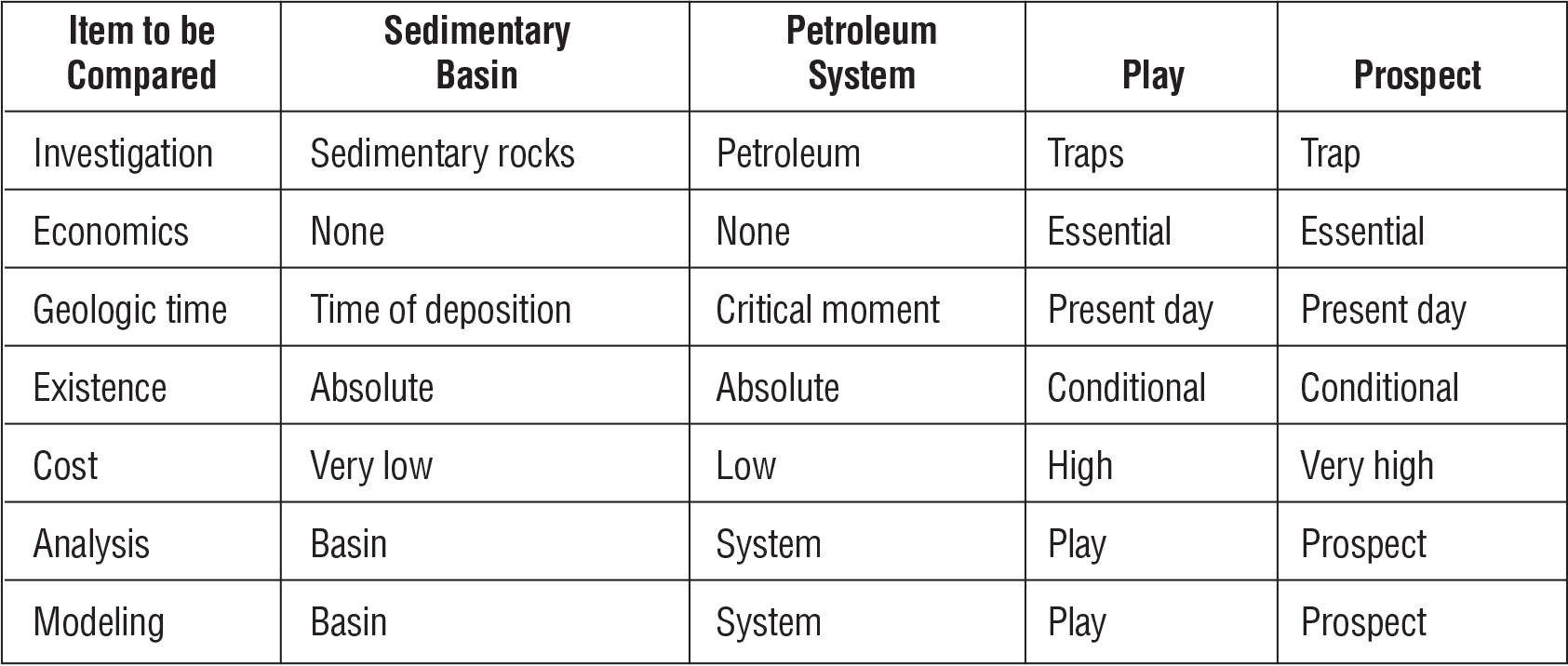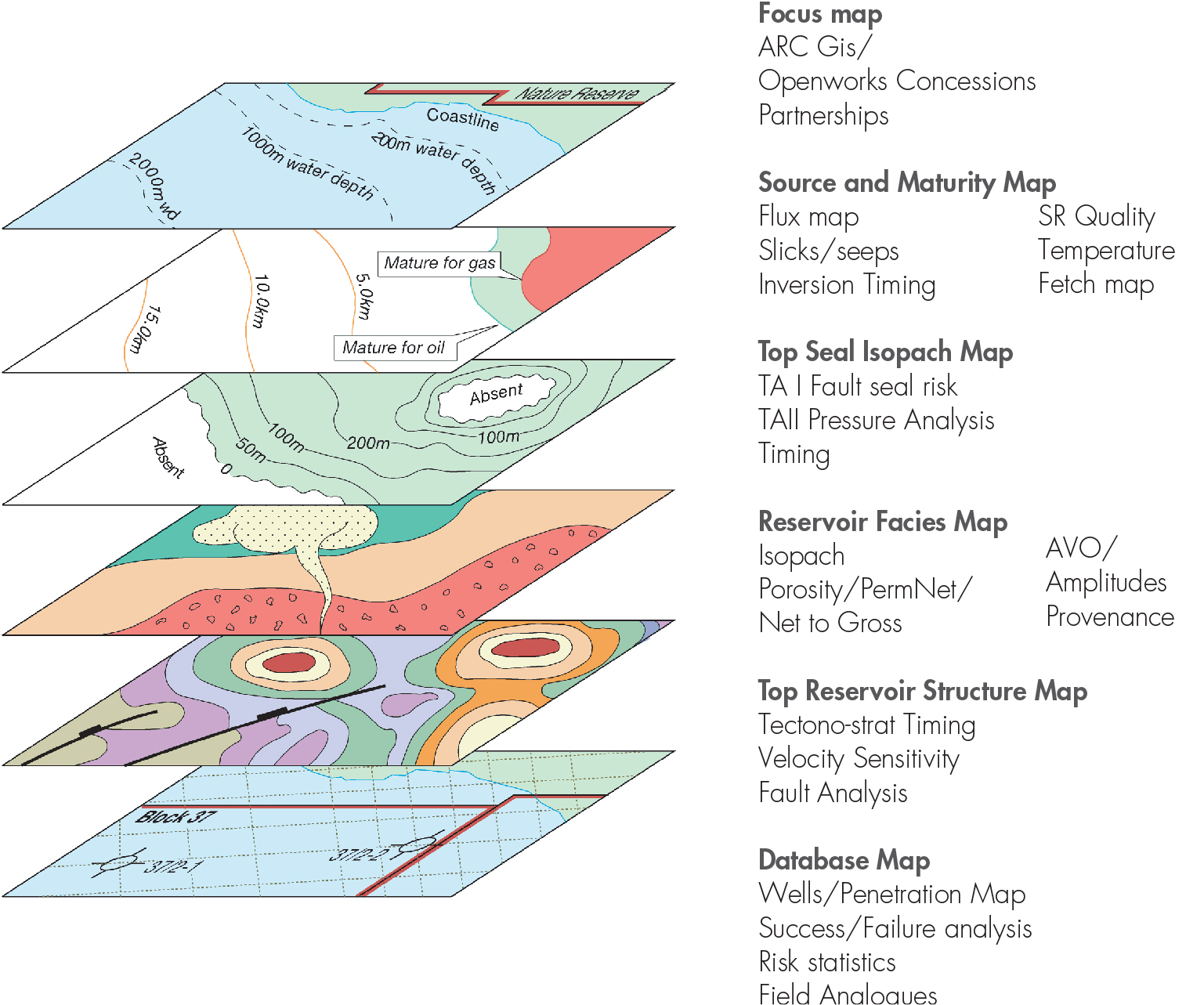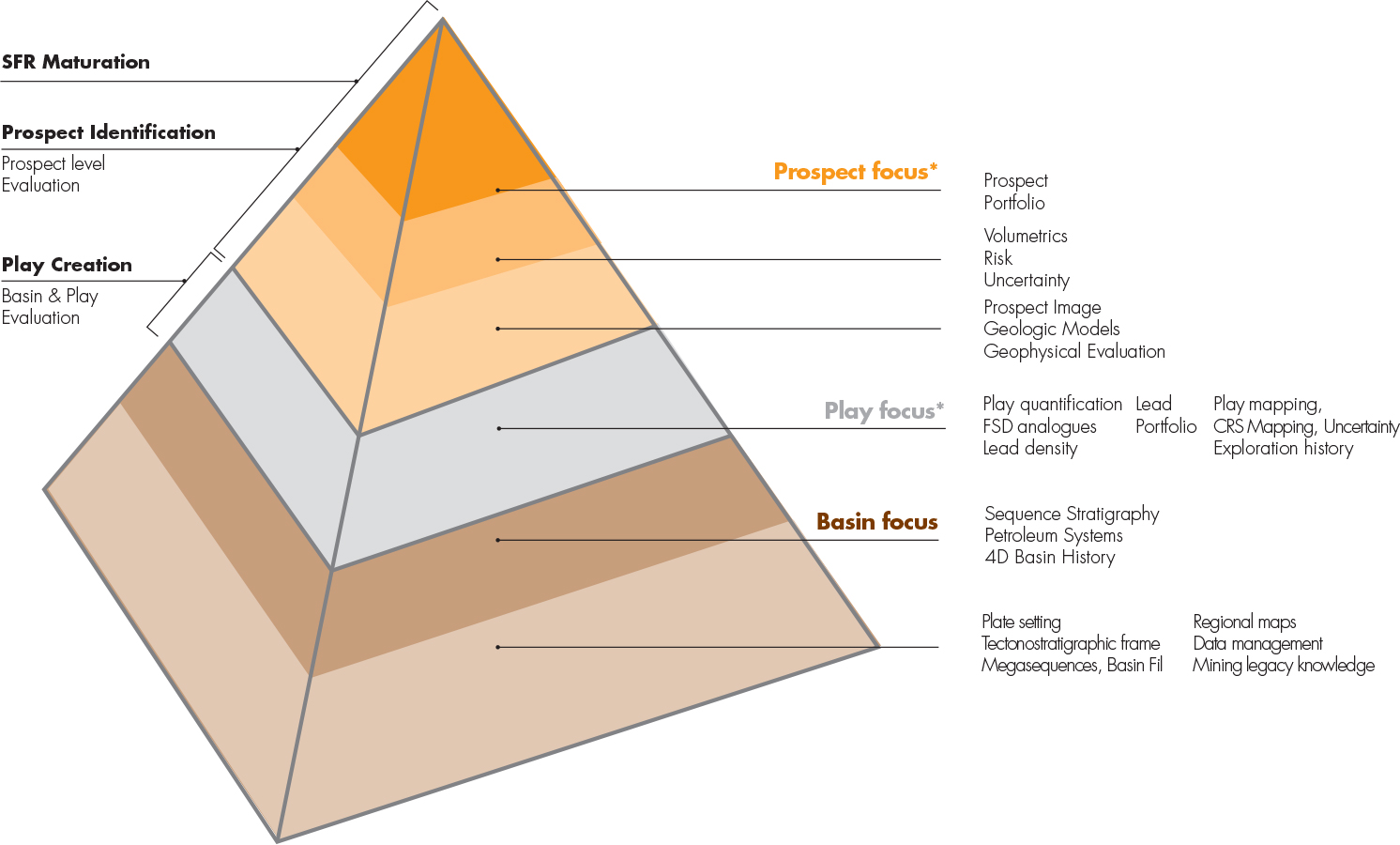On this page
Play-based exploration hierarchy
Figure 1. The play-based exploration pyramid (Royal Dutch Shell, 2014)
Basin
A depression filled with sedimentary rocks, formed by any tectonic process, and lined by basement rock, which can be igneous, metamorphic, and/or sedimentary in origin. The basin fill includes the rock matter, organic matter, and water deposited in this depression. In certain cases, such as with coal and some carbonate deposits, the sedimentary material is formed in situ. The essential elements of a petroleum system are deposited in sedimentary basins. Frequently, one or more overlapping sedimentary basins are responsible for the essential elements of a petroleum system, and a basin can contain more than one petroleum system.

Table 1. Comparison of Sedimentary Basin, Petroleum System, Play and Prospect (Magoon and Beaumont, 1994)
Petroleum system
A natural system that links an active or once active source rock to all the geological elements and processes that are essential for a hydrocarbon accumulation to exist in time and space regardless of economics, such as carrier beds, reservoir rocks, seals and overburden, trap formation, migration, accumulation and preservation. The moment petroleum is generated, biologically or thermally, a petroleum system is formed, thus the presence of petroleum is proof that a system exists. A petroleum system can “source” more than one play.

Figure 2. Schematic of a petroleum system (Magoon and Beaumont, 1994)
Play
A trend or family of geologically related leads, prospects, and possibly producing fields, with primary elements of similar geological history of hydrocarbon charge, reservoir/seal pairs and trap controls on their occurrence. They are typically defined by stratigraphic name or age, with plays generally separated stratigraphically by a regionally significant master seal. The areal extent of a conventional play is generally defined by the maximum areal juxtaposition of the primary reservoir and seal, outside of which there is ZERO chance that the play will be found (e.g.- reservoir or seal are totally eroded, source rock is at 10m below surface, etc).
Several trap types may be present within a play although frequently one trap type is more dominant or more prolific in terms of hydrocarbon resources. Commonality of trap type enables statistical analysis to be conducted.
Play-Based Exploration (PBE) is a process to define plays primarily concerned with defining prospects for drilling. An understanding of the petroleum system in the basin leads to the identification, mapping and quantification of plays. Existing knowledge is summarised in play element, summary play maps, and common risk segment maps, leading to the identification of sweet spots, the maximum vertical coincidence of all the elements of the petroleum system for this play: reservoir, charge and seal.

Figure 3. Basic components of play mapping (Royal Dutch Shell, 2014)
Prospect
A technically mature subsurface exploration opportunity, with the potential to contain commercial quantities of hydrocarbons, that consists of one or more untested potential traps or objectives in one or more plays.
Following evaluation of the play, a geological model is built, and a series of prospects identified, with each prospect represented on a given structural or stratigraphic surface by an all-encompassing polygon to cover the extremities of all the targets combined. Estimation of volumetrics, technical risk and commercial issues are assessed, followed by drilling if justified to determine whether it contains commercial quantities of petroleum. Once drilling is complete, the term “prospect” is dropped; the site becomes either a dry hole or a producing field.
Prospects can be structural, stratigraphic, or combination traps. The estimated number of prospects in a play or play segment is one of the key inputs needed to calculate undiscovered potential in a play or play segment.
Target
The lowest level of the Play-Based Exploration hierarchy, defined as a potential hydrocarbon trap with one or more reservoir/seal pairs. Stacked reservoirs may be assessed as a single target if appropriate.
Glossary
A term used collectively for all aspects of source rock presence, maturity, timing of hydrocarbon generation, and migration pathways to discovered accumulations, seeps and shows, and to potential traps if they exist. The volume and characteristics of the oil and gas available to a trap may also be included.
The subdivision of a geological play into smaller polygons that contain the same general chance for success and confidence for a given chance factor such as reservoir, charge, seal or structure. Boundaries between segments indicate differing chance characteristics due to some abrupt and significant change in the underlying geology of the play. CRS maps give an indication of chance elements for the probability of success of a play or prospect.
A broad descriptive term that describes the combination of physical, chemical and biological processes associated with the deposition of a particular type of sediment and, therefore, the rock types that will be formed after lithification. Gross depositional environments span multiple facies which may include potential reservoirs and seals. GDE maps are generated as part of the process for understanding plays.
A significant process whereby the fundamental logic of geological plays is explicitly understood and fully utilised to support the range of decisions through the exploration life cycle, from play entry through execution of an exploration program. The methodology incorporates the integration of seismic data, well log and palynological data, structural analysis, geochemistry, 3D basin modelling, consistent well failure analysis and gross depositional environment mapping to generate a series of play maps that can be used to focus exploration strategy and improve prospect chance assessment. Analysis of plays using this process is not static, with iterative feedback required following new information from drilling, seismic data, studies etc to update the knowledge base and keep it evergreen.
Rock strata with sufficient porosity and permeability to store hydrocarbons, which may flow naturally or may require fracture stimulation to achieve flow. This may include fracture porosity and permeability.
Rock strata with sufficiently low porosity and permeability to retain reservoired hydrocarbons in a structural or stratigraphic trap by preventing movement through them. Possible seals include top seal, seat/base seal, lateral seal, fault seal (juxtaposition of impermeable beds against reservoir strata), or stratigraphic/pinch-out seals. In unconventional accumulations, the seal is sometimes formed by capillary pressures within a gas/water transition zone updip from the actual accumulation.
A rock strata interval with sufficient organic matter to be a future source of hydrocarbons. Usually suitable extent and thickness, organic content, and thermal maturity are required to generate hydrocarbons.
The branch of geology concerned with the order and relative position of strata and their relationship to the geological timescale.
A closed volume of rock within which hydrocarbons might accumulate. The enclosed rock consists of a reservoir, and the closure is provided by a surface or surfaces that the hydrocarbons cannot cross (the seal). In the simplest case the closed surface is the contact between the reservoir and an overlying seal deformed into a convex-upward shape, from which any petroleum cannot escape.
References
Longley, I. and J. Brown, 2016: Why Bother? (with Play Based Exploration): The five reasons why Play Based Exploration worthwhile in a modern busy understaffed and overworked exploration company environment; AAPG Search and Discovery Article #110227 (2016)
Magoon, L.B., and E.A. Beaumont, 1994: Petroleum Systems, In Magoon, L.B., and Dow, W.G. (eds), 1994: The petroleum system - from source to trap; AAPG Mem. 60, 655pp.
Milton, N.J. and G.T. Bertram, 1992: Trap Styles – A new classification based on sealing surfaces; AAPG Bulletin, v76, pp 983-999
Rose, P.R., 2017: Evolution of E & P Risk Analysis (1960-2017); AAPG Search and Discovery Article #42063 (2017)
Royal Dutch Shell, 2014: Play Based Exploration, A Guide for AAPG’s Imperial Barrel Award Participation



